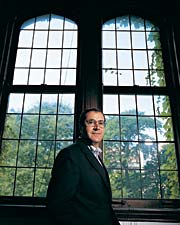|
Photo: Katrina Wittkamp |
| Galenson on campus |
THE RESEARCHER: David Galenson, 54, a professor of economics at the University of Chicago
THE BIG IDEA: In his forthcoming book Old Masters and Young Geniuses (Princeton University Press), which draws on about two dozen studies he has published since 1997, Galenson argues that artists consist of two types-conceptual and experimental. Depending on which camp the artist falls into, he will do his greatest work early or later in life. By Galenson’s accounting, conceptual artists introduce bold innovations that they conceive quickly, while experimentalists develop their technique through trial and error over a long period of time. For example, Galenson calls the Dutch artist Piet Mondrian an experimental artist, because he began his career painting realistic landscapes, then gradually simplified them to arrive at the black lines intersecting with color that mark his best-known works. By contrast, “Picasso got to Cubism in ten minutes,” Galenson says, “because the light bulb went on. The light bulb never went on for Mondrian. He’s always experimenting, always changing.” Galenson acknowledges that this distinction between working types is well known. His advance is in recognizing that these two types have radically different life cycles in creativity. Galenson posits that conceptual artists-such as Orson Welles, F. Scott Fitzgerald, and Andy Warhol-tend to reach a creative peak early in their careers, when they make the first artistic statement of their groundbreaking ideas. Experimental artists-among them, Alfred Hitchcock, Virginia Woolf, and Mark Rothko-typically do their best work later in life, when they have developed their technique.
HOW DOES HE DEFINE ‘GREAT’ ART? For artists, in addition to comparing auction prices-a standard that has drawn objections from the art establishment-Galenson also quantifies the number of an individual’s paintings that are represented in major exhibitions and reference books; by this measure, for example, Picasso outnumbers Cézanne 333 to 136 in the 33 art history textbooks Galenson examined, but Cézanne has 82 representations of paintings he made after age 49 compared with Picasso’s 51. For poets and writers, he counts citations in literary anthologies and monographs, respectively. For movie directors he uses video guides and the film journal Sight and Sound‘s listing of the best movies ever made, which is based on its once-a-decade survey of international critics and directors asking them to name the ten best ever made. His analysis also incorporates the comments of critics, colleagues, and the artists themselves about their working methods.
SO WHAT’S AN ECONOMIST DOING STUDYING CREATIVITY? Galenson previously studied the earnings of paid laborers, indentured servants, and slaves. His interest in art began in 1997 when he bought a drawing by Sol LeWitt. “The question came to me, had the value of his work gone up or down over the course of his career?” he says. He began gathering data on the prices that the works of famous modern American painters fetched at auction, and was surprised to learn that some artists’ work (including that of Jackson Pollock and Mark Rothko) increased in value as their careers progressed, while the work of others (Jasper Johns, Andy Warhol) declined. His next study will examine the creative life cycles of the greatest living American novelists.
WHY HIS RESEARCH MATTERS: Galenson believes his findings are applicable to every kind of creative intellectual activity. Experimental people shouldn’t try achieve innovation in the same ways as conceptual types. Instead, Galenson advises, “do what you do best and try to improve it; recognize that craftsmanship is important. If you take a new problem make sure it’s a problem that’s close enough to your old work.” To avoid getting stuck in a rut, conceptual people need to do just the opposite, he says. “Change problems. Do something so different that you can’t use the same approach that you used in your earlier work, whatever the innovation was.”
WHICH TYPE IS HE? Experimental. “I didn’t see [this theory] in advance,” he says. “It was a fortunate accident, which is the way experimental people typically come to things.”



